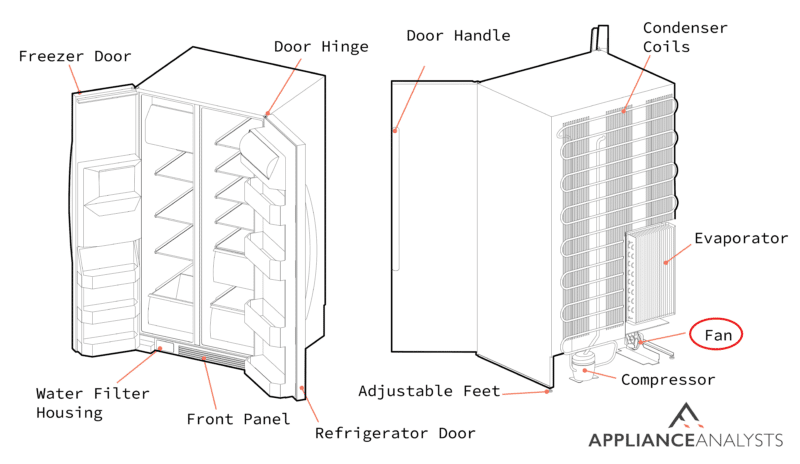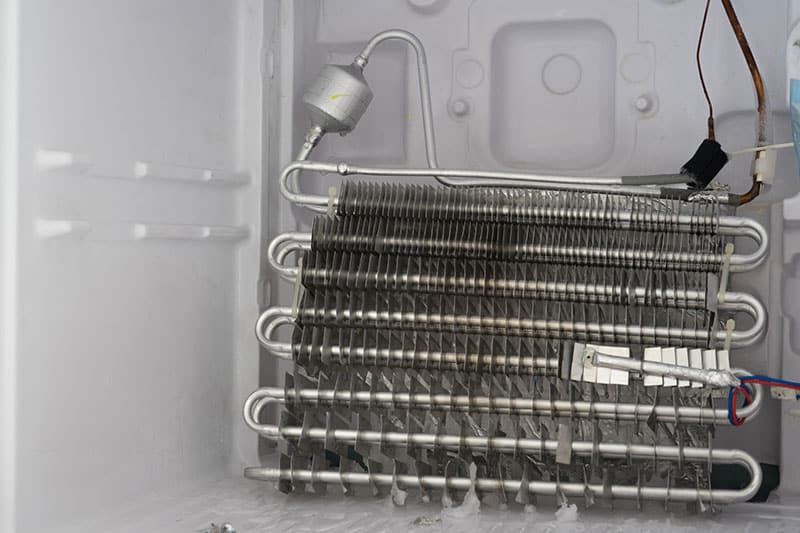A fridge that won’t turn off is a common issue, but thankfully there are a few DIY fixes you can try.
A fridge that is always running will be a huge drain on your energy bills. Your fridge consumes a lot of electricity, and the situation gets worse if it won’t stop running. Not to mention that a refrigerator that won’t stop running is likely struggling to stay cold.
When your fridge is having trouble staying cool, it could be due to things as simple as dirty condenser coils or a broken fan motor. Luckily, repairing the components can be quickly done at home with minimal skills and equipment.
Ready to stop your fridge from running constantly? Let’s dive in!
Why trust us? This article was written by Craig Anderson and Andy Fulenchek.
Craig has helped thousands of other homeowners repair their appliances since 2016.
Andy is one of our resident appliance repair experts with over a decade of experience. He currently runs his appliance repair company with a team of trusted technicians.
Why Does Your Fridge Run Constantly?
When your refrigerator won’t stop running, it can be due to several factors, including importer cleaning and maintenance. Although there are many approaches to address the issue, here’s what I recommend you check and try first.
#1 Clean the Condenser Coils
Your fridge’s condenser coils have one of the most important jobs. The coils dissipate the heat that builds up in and around the appliance, and along with the refrigerant, they both keep things cool. Condenser coils can become clogged with dust, hair, and debris. My usual advice is to clean your fridge’s condenser coils at least once a year to help prevent any problems.

Here’s what you’re going to need to clean your condenser coils.
- Unplug your refrigerator.
- Carefully slide your fridge out of the wall.
- Remove the condenser coil cover. The coils should be located at the bottom of the back of the fridge and held in place with screws or nuts.
- Clean your condenser coils with your vacuum’s brush attachment. You can also clean the coils with a rag or a brush, although it’ll take much longer.
- Reassemble your fridge.
- Slide your fridge back into place and plug it in.
#2 Check Your Temperature Settings
You might have to deal with some temperature control issues when your refrigerator keeps running. There are a few different temperature controls inside your fridge that we’re going to need to check to either rule out or confirm a problem.
Your fridge should be at 40 degrees Fahrenheit, while the freezer should be at 10 degrees Fahrenheit. I find that setting either higher can cause serious problems.

The biggest problem is food spoilage. Food needs to be kept at low temperatures to be safe to eat. Food can begin to grow bacteria and mold when it gets above the abovementioned temperatures.
Your refrigerator can also struggle to keep things cool if the temperatures are set too high. Temperatures that are set too high mean that the fridge heats up quicker, causing it to stay on constantly to keep things cool.
On the other hand, when the cold control is failing (which is more common on older appliances), your fridge won’t be able to detect when it’s cold enough and will keep sending power to the compressor.
#3 Faulty Fan Motors
If your refrigerator won’t stop running, its fan motors are likely faulty.
The fans are designed to exhaust hot air and bring cool air back into the fridge. If any of the fans fail, your fridge must constantly work to maintain a cool temperature.

To replace a faulty fridge fan motor:
- Unplug your fridge and move it slowly away from the wall.
- The condenser fan is at the bottom of the back of the fridge.
- The evaporator fan is located right above the evaporator coils.
- Examine the fans.
- The fans should spin freely and not be too hot.
- You can replace either fan by unscrewing it from its mounting and disconnecting the electrical cable connectors.
- Connect your new fans.
- Screw the new fan back into the mounting.
- Reinstall any covers you had to remove.
- Slide your fridge back into place and plug it in.

#4 Frosted Evaporator Coils
When your refrigerator won’t stop running, it could also be due to frosted evaporator coils.
Like the condenser coils, the evaporator coils play a key role in your fridge’s daily operation. After the liquid refrigerant is condensed in the condenser coils, it expands in the evaporator coils and cools down your food.

Evaporator coils can develop a layer of frost, inhibiting their ability to keep your fridge cold and causing it to run constantly but you.
Here’s how you can get the frost off your evaporator coils:
- Empty everything out of your freezer.
- Unplug your fridge.
- Follow your manufacturer’s instructions for accessing your evaporator coils. The coils are typically located behind an access panel in the freezer. You will need to remove the panel with a screwdriver.
- If your evaporator coils are covered in frost, you’ll need to defrost them.
- Set all of your fridge’s thermostat controls to their warmest settings.
- Keep your freezer door open and allow the frost to melt.
- Dry off everything in your freezer.
- Plug your refrigerator back in.
- Once the fridge is nice and cool, push your food back into the refrigeration and freezer compartments.
In my experience, getting the frost off your evaporator coils is only a temporary solution. You’ll need to figure out how the coils developed frost in the first place.
#5 Problems With the Defroster
If your refrigerator won’t stop running, its defroster could be failing to work properly.
The defrost heater assembly, defrost thermostat, defrost timer, and defrost control board all work together to keep your fridge frost free. Any of these components can break down and cause your fridge to run constantly.
Fixing problems with your defroster can be a little tricky. You’ll need to inspect each component separately to find the one which isn’t working correctly.
Once you’ve located the faulty fridge defroster component, you’ll need to replace it. More often than not, it’s better to leave the repairs to a professional technician. Along with the compressor, the defroster assembly is your refrigerator system’s single most complicated part.
#6 Replace Your Door Gasket
There is a gasket that forms a seal every time your fridge or freezer door closes. Any damage to the gasket could explain why your refrigerator won’t stop running. Gaskets are made out of flexible rubber material that can break down and become brittle over time, causing them to no longer seal the door shut.
It’s pretty easy to tell if you have a broken door gasket on your fridge. You’ll notice that the fridge no longer seals shut on its own but instead freely swings open after you close it. You can also feel cold air blowing out from the crack in the door.

Here’s how you can replace a fridge door gasket:
- Use a flathead screwdriver to pry one corner of the gasket out of the fridge door.
- Slowly peel the gasket out of the fridge door.
- Use household cleaning supplies to clean the door.
- Pop the new fridge gasket into one of the corners of the door, making sure to line them up.
- Slowly feed the gasket into the door.
- Ensure the gasket fits properly by closing your door and ensuring the seal is tight.
If you want to get any replacement part – or see how much one would cost – click to enter your model number in the search bar below. Our partners at AppliancePartsPros stock almost every part with free guides on how to install them.

#7 A Broken Main Control Board
If all else fails and your refrigerator still won’t stop running, you could be dealing with a broken main control board/relay.
The main control board is the brain of your fridge. The little piece of circuitry controls all of your fridge’s systems and ensures that they run on time and normally. If the main control board fails, your fridge can start to run constantly in an attempt to compensate for the broken component.
The control board can be replaced just like any other part of your fridge. However, some things must be taken into consideration.
The control board/relay is not cheap, so, in my opinion, unless your fridge is a high-end model or brand-new, you should never pay for repairs worth more than 50% of the price of a replacement fridge with the same features.
Is it Bad if Your Fridge Always Runs?
Yes.
There are a few reasons why it’s bad if your fridge is constantly running.
The most obvious reason is that constant operation will increase your energy bill. Your fridge consumes a lot of electricity; if it never shuts off, it’s bad news for efficiency.
Also, If your refrigerator won’t stop running, it likely means it’s struggling to keep things cool. The situation puts your groceries and your health at risk, as eating spoiled food by accident can be dangerous.
How Much Do Fridge Repairs Cost?
Although the price of repairs varies depending on the fridge model you own, the part that needs replacement, and your technician of choice’s hourly rate, there are ballpark estimates. Here’s how much you should expect to pay for a faulty fridge repair.
| Faulty Component | Repair Price |
| Control Board | <$400 |
| Fans | $300 |
| Compressor | >$1,000 |
Fixing a Refrigerator That Won’t Stop Running
That about covers it!
When your refrigerator won’t stop running, it’s understandable that you grow concerned over your utility bills and the appliance’s functioning.
Luckily, as I hope this piece has helped you better understand, addressing the most common causes behind a refrigerator that won’t stop running is easy and quick. Unless you’re dealing with a broken compressor or something of the sort, a good cleaning session can get things back to normal.
Thanks for reading. If this article was useful and answered your most burning questions, please check out our other resources and free guides below and consider subscribing to our newsletter.
Have a great day!
-Craig.








